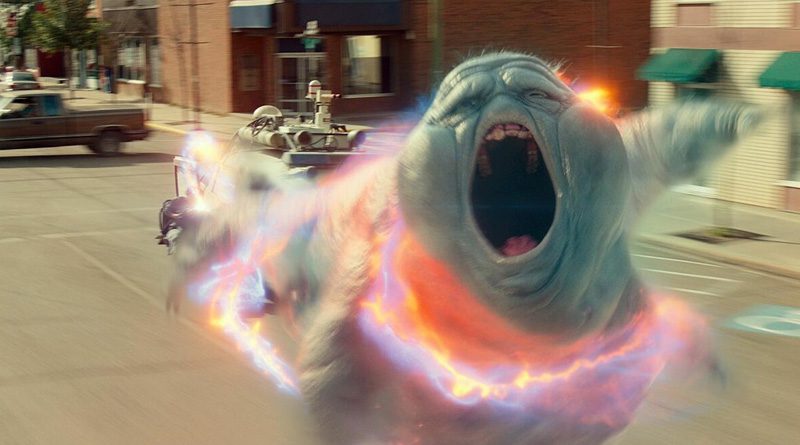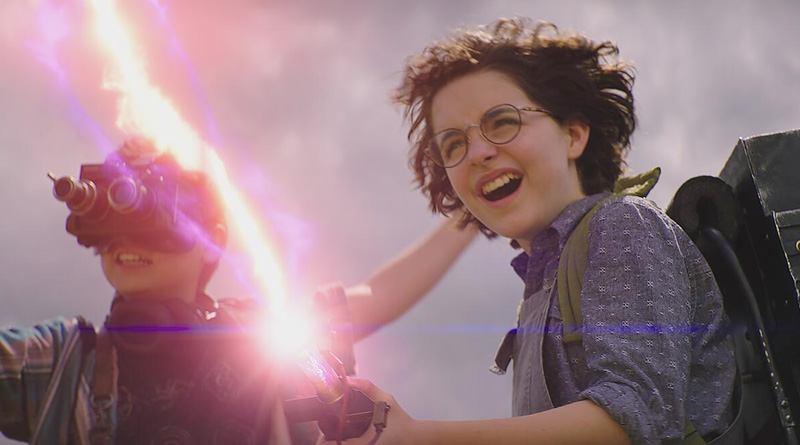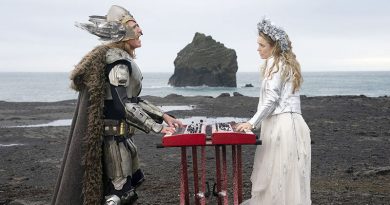Ghostbusters: Afterlife (2021) Review
Okay, first of all, I’m going to pretend the 2016 abomination of an all-female reboot nobody asked for (the retrofitted Ghostbusters: Answer the Call) has never existed. To me, the Ghostbusters franchise belongs only to the first two films released in 1984 and 1989 and to a certain extent, the 2009 video game. The long-gestating Ghostbusters 3 (officially titled Ghostbusters: Afterlife), which has suffered from decades of development hell (more on this later), is finally resurrected under the direction of Jason Reitman (yes, that’s Ivan’s son).
Here is what you need to know about the third film: Single mom Callie (Carrie Coon) and her two kids, Phoebe (Mckenna Grace) and Trevor (Finn Wolfhard) find themselves evicted from their home after she failed to pay her overdue rent. Broke and barely surviving, she has no choice but to move into her late father’s — Egon Spengler’s (Harold Ramis, who appeared in the first two films) — derelict farmhouse in the (fictional) sleepy town of Summerville, Oklahoma.
Once there, it doesn’t take long before the kids manage to adjust to their new surroundings. Phoebe, who has a passion for all things science, ends up in a summer school and befriends a kid (Logan Kim) named Podcast because, well, he likes to make a podcast and teacher/seismologist Gary Grooberson (Paul Rudd). Trevor, in the meantime, is attracted to a local waitress named Lucky (Celeste O’Connor) and decided to fill in the employment form working at the same burger joint so he has the chance to get closer to her.
Then, strange things start to occur when Phoebe first discovers a P.K.E. Meter under her late grandfather’s couch and later, the ghost trap hidden under the wooden floor. Long story short, Phoebe and Trevor eventually find out their late grandfather, Egon used to be a big deal back in the 80s when he was one of the ghostbusters team who saved New York, thanks to an old YouTube clip.

I was initially sceptical about Jason Reitman taking over his father as the director for Ghostbusters: Afterlife. Besides, his prior resume is mostly small-scale dramedies as seen in his acclaimed films like Juno (2007), Up in the Air (2009) and Young Adult (2011). Ghostbusters: Afterlife marks his first time venturing into a big-budget studio picture and particularly, genres (sci-fi and supernatural-horror comedy) that are outside his usual comfort zone.
Fortunately, right from the start where the familiar music bits played in the opening credits, Jason Reitman does a good job setting up the film’s ominous tone. It also hinted at what Reitman is capable of here in the earlier part, especially the way he integrates both practical and special effects, camera angles, lighting, suspense and music to stage such a promising prologue.
Even the film slows down afterwards to make way for the introduction of the new characters, Reitman thankfully neither drags nor stalling the momentum. In other words, I like how he builds up the new characters and subsequent things that happen around them. I can say it’s like watching an early Amblin-style adventure seen in the likes of Gremlins (1984) and The Goonies (1985). The suburban setting is also a nice Spielbergian touch that evokes an immediate sense of nostalgia.
Reitman also has a field day peppering the film with lots of Easter eggs (some obvious, some blink-or-you’ll-miss-them) related to the previous two Ghostbusters. As mentioned earlier, he truly excels when it comes to character development, even though they are new ones prominently featured in the third Ghostbusters film. Mckenna Grace steals the show as Pheobe, where she cleverly alternates from the awkward and geeky to a quietly rebellious 12-year-old kid. Stranger Things‘ Finn Wolfhard deserves equal mention as Phoebe’s older brother, Trevor while Logan Kim provides some worthwhile comic relief as Podcast.

The adult cast, in the meantime, all deliver solid supporting turns, beginning with Callie Coon as the struggling single mom trying to adapt to her new life living in her late father’s farmhouse. Paul Rudd displays his usual goofy charm with excellent results as Gary Grooberson and also shares terrific, though brief chemistry with Coon’s Callie.
Given the fact this is a true sequel to the first two Ghostbusters, Reitman doesn’t forget the original cast and here, it’s nice to see the three ghostbusters — Bill Murray’s Peter Venkman, Dan Aykroyd’s Ray Stantz and Ernie Hudson’s Winston Zeddemore — are back together after the underwhelming 1989 sequel. Harold Ramis, who played among the fan-favourite ghostbuster, Egon Spengler may have passed away seven years ago in 2014 but I appreciate how Reitman honours his legacy here. Let’s just say it was a smart move that is both emotional and poignant. I’m also glad Reitman addresses the elephant in the room and does justice to one of the characters (if you are a fan of the film, you’ll know it when you see it).
The screenplay — credited to Gil Kenan and Jason Reitman himself — may have relied heavily on nostalgia or more appropriately, the ghosts of the past in Ghostbusters: Afterlife. It was a result that at times, feels as if Jason Reitman wants to redo his father’s original Ghostbusters but takes place in a scaled-down, small-town setting and with kids instead of adults as the new ghostbusters. Even the ghosts — the Terror Dog, Stay Puft Marshmallow Man (this time appeared in cute, mini-size forms) are making the comeback in this third film and yet, this is one of the rare cases where familiarity and callbacks surprisingly work well in this film. In the lesser hands, such an approach will be easily dismissed as mere, empty fan service but Reitman executes this nostalgia-heavy sequel with enough heart, fun and thrills.
Speaking of fun and thrills, Ghostbusters: Afterlife scores in the effects and other technical departments, with the aforementioned prologue being one of them. The elaborate car chase sequence is the major highlight here, where Phoebe trying to blast the escaped ghost nicknamed Muncher with a proton pack while riding the beat-up Ecto-1 (love the added gunner seat). The combination of practical and special effects are mostly top-notch, coupled with the impressive sound design and of course, Rob Simonsen’s spot-on spooky and energetic score that seamlessly integrated with the late Elmer Bernstein’s iconic themes.

Although Ghostbusters: Afterlife mostly hits the right spot, there are some setbacks that are impossible to ignore here. This is especially true during the climactic third act and looking at how Reitman and his team handle the effects-heavy set pieces seen in the prologue and the car chase moment, I’m expecting him to go all out. As in a spectacular payoff after all the promising teases and build-up tensions.
After all, it has been 32 years since Ghostbusters II made its theatrical debut and with all the moviemaking technology is no longer bound by limitations, I personally feel the film deserves a larger-scale finale since both new and old characters are dealing with ghostly antagonists hell-bent on possible mass destruction. Blame it on the scaled-down US$75 million budget, thanks to the 2016 tepid reboot that failed to turn a profit after spending US$144 million on the production cost alone.
Earlier in the first paragraph, I have mentioned the third Ghostbusters film’s troubled production history, stretching way back to 1989 (yes, at the time of Ghostbusters II‘s release). Getting the original gang back together for the third round was plagued by numerous rumours and setbacks over the decades (at one point, Ivan Reitman himself wasn’t initially interested to do another Ghostbusters film and Bill Murray famously refused to participate for quite some time).
But in a perfect world, they would have appeared in the third film because Harold Ramis and Dan Aykroyd had actually come up with a draft under the working title of Ghostbusters III: Hellbent. The film would feature the ghostbusters trapped in an alternate, hellish world of Manhattan a.k.a. Manhelltan and encounter various demons and supernatural entities. I remember I first read about this in a magazine decades ago and felt intrigued by the proposed third film’s wild idea. Too bad that didn’t work out since it requires a whole lot of special effects and a bigger budget to pull this off.
Back to Ghostbusters: Afterlife, the third film may have not reached the same creative heights seen in the 1984 beloved original but kudos still goes to Jason Reitman for pulling it off an overall good film. Remember not to leave your seats once the film ends since there are mid and post-credits scenes, with the latter being particularly an important one not to be missed.





